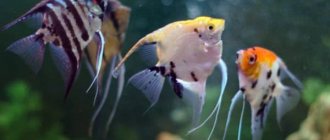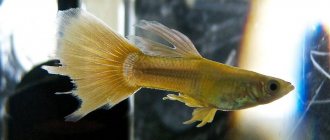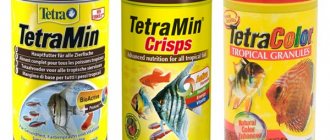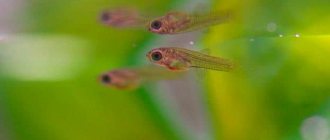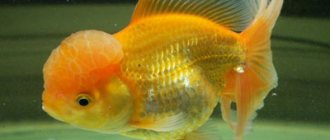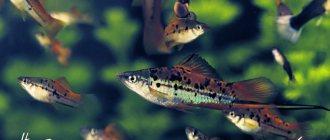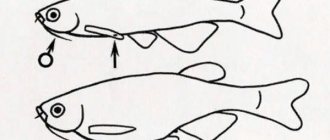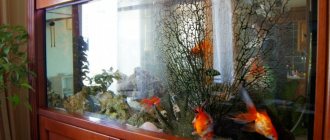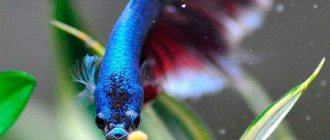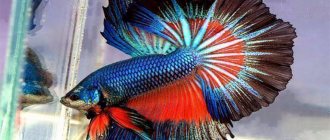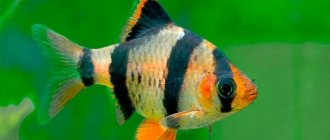Cockerel
Bettas are beautiful aquarium fish that have earned a bad reputation due to their personalities. Alas, these fish are pugnacious and do not tolerate either intraspecific proximity or with many other species. However, there are certain breeds that are loyal to such temperamental neighbors. Before combining several individuals of different species in one space, you must definitely find out the compatibility of the cockerels. Otherwise, conflicts can even lead to the death of its participants.
Cockfighting is a deadly competition.
Description and character of cockerels
The body length reaches 5 centimeters. Thailand is considered its natural habitat. They live in bodies of fresh water. The color can be varied. There are individuals of yellow, red and green colors. Males become slightly brighter during the breeding season or during conflict with another individual. When light hits, the body shimmers with different colors.
In the aquarium industry, it was possible to breed a new specimen of female aquarium betta fish. Such individuals are extremely rare.
There are many stripes along the entire length of the body. There is a pointed fin on the chest. The dorsal fin extends all the way to the tail and has a more rounded shape. During a fight, the gills take the form of a collar, which is located around the head.
In Thailand there are special fights involving these creatures. There are bets on some fights.
How to distinguish a male from a female betta
Adult betta fish have fairly distinct sex differences. The male is larger, has a brighter color, and has longer fins. Until 2 months of age, it is much more difficult to distinguish a female from a male, but there are still several differences:
- the female has a wide and round ventral fin;
- a more rounded abdomen, on which the ovipositor (white dot) is visible;
- she is calmer and less aggressive.
Who do cockerels get along with?
Betta fish have extremely poor compatibility with other fish. Successful cohabitation depends on the species of inhabitants and the proper arrangement of the aquarium.
Mollies
They get along well with bettas. The fish has a calm character and a dull body color. Usually cockerels do not pay attention to such cohabitants. Conflict situations between fish do not occur. When breeding babies, mollies need to be moved to a separate container.
Botsia fish
She is able to get along with the cockerels only if there are decorations and shelters. They need to be housed in numbers of 2–4. It is required to closely monitor the battles.
Ancistrus
The sticky catfish has a dull body color. Both species do not tolerate salt water and live in fresh water bodies. With such cohabitation, the presence of algae in the aquarium is necessary.
Ancistrus and cockerels
Gourami
They become a good companion if you have a spacious aquarium. In color and character they resemble cockerels. There are no fights between the fish. The inhabitants live peacefully among themselves.
Catfish corridors
They lead a quiet lifestyle. They get along well with cockerels, as they act as a natural cleaner and live at the bottom of the tank. You can keep fish together even without decorations and shelters.
Neons
Cockerels can also cohabit with neons. The only drawback is the inconsistency with the temperature regime that is necessary for the life of these species.
Cockerel with neon
Rasbory
The dull coloration of the body of this fish makes keeping it with a cockerel conflict-free. She is much more agile than a betta and can easily escape if attacked. The presence of algae and shelters is necessary.
Incompatible species
Some fish are strictly contraindicated in proximity to cockerels. They can be divided into three groups - the first can suffer from the aggression of cockerels, the second itself poses a danger to bullies, and the third are not suitable for the conditions of detention.
Guppy
These fish should not live with bettas, since as a result of their proximity, the fins and tails of smaller individuals may suffer. In addition, the small size of guppies provokes aggression in males.
Goldfish
These beautiful fish cannot live together with bettas due to different requirements for the temperature range of the water. In addition, the fish differ significantly in size, and the veiled fins of goldfish run the risk of being bitten by cocky bettas.
American cichlids
These are large aggressive fish that look at bettas and other small fish solely as prey. If you introduce bettas into an aquarium with American cichlids, the latter will be immediately eaten.
African cichlids
These are aggressive fish that tend to destroy any small fish. All neighbors who are inferior in size to territorial cichlids run the risk of becoming their victims. Cichlids will simply kill the bettas.
Tetraodons
These fish belong to the Four-Toothed family. They are very confrontational and do not get along well with their neighbors. Tetraodons will definitely tear off the fins of the cockerels. In addition, these fish love salted water, but it is contraindicated for bettas.
Cherry shrimp
Due to the small size of cherry shrimp, as well as other species, they often become prey for active and voracious bettas. Shrimp are especially often eaten after molting and at a young age.
Who shouldn't be in the aquarium
Cohabitation with shrimp does not bear fruit, as they are food for the betta. Young individuals suffer especially, as they cannot protect themselves.
Black-striped cichlasoma does not always get along with a cockerel. These fish are pugnacious and are accustomed to defending territory. They can only get along in large aquariums with shelter and algae.
It does not consume plants as food, as it is a predatory fish by nature. When setting up an aquarium, it is necessary to choose soft algae so that the fish does not injure its fins.
Origin and distribution
Crowntails come from sunny Thailand, which was once called Siam (hence the name of the species - Siamese cockerels), where they lived in puddles of rice plantations and shallow ditches. In their appearance, modern bettas differ from their wild ancestors, which is explained by careful breeding to improve characteristics, fin color, size, etc. The first such cockerel was bred using a selective method in 1996, by the Indonesian beta breeder Ahmad Yusuf.
Males differ from females not only in
larger in size, but also long beautiful fins on the belly, back and tail.
Betta Compatibility Chart
Successful cohabitation depends on several factors. The main ones are:
- tank volume;
- the presence of shelters;
- characters of representatives.
The table provides information on the compatibility of bettas with other species of aquarium inhabitants.
Betta Compatibility Chart
What do betta aquarium fish eat?
Recommendations for feeding a betta
- How much food should I give my betta?
Give your betta as much food as he can eat in 2 minutes. Place 4-6 grains of food on the surface of the water and see how quickly he handles them. If the fish does not take this food, or starts spitting it out, this is not a good sign. Either the food was not suitable, or the fish was not used to it, or got sick. If she doesn't eat the food, it will sink to the bottom of the tank where it will begin to decompose, releasing ammonia. This substance will cause the fish to feel worse and create an extremely unhealthy biological environment. If the aquarium is not cleaned in a timely manner or the water is replaced incorrectly, it will be difficult to maintain the health of the pet.
Also, if your betta goes beyond eating within 2 minutes, he will become accustomed to this type of feeding. It turns out that the fish will begin to overeat. Having examined the abdomen and noticed a significant bulge on it (in the area of the ventral fins), you know that the fish is overweight.
- How often should I feed my Betta fish?
Young males purchased in stores should be fed in small portions 1-2 times a day. Aquarium fish do not need to be fed often; it is better to feed them a little and add food if they ask for it. During the spawning period, fish are fed 2 times a day, fry betta bettas are also fed 2 times a day.
For these fish, it is useful to arrange fasting days, skipping meals. The digestive system will take a “break” to recover, allowing the body to get rid of accumulated toxins. It's good to skip one day of eating. You can choose Sunday, when many will be at home, minding their own business. On weekdays, feeding should be resumed.
What to feed your cockerel?
Despite the fact that betta bettas are omnivorous creatures, they lead a predatory lifestyle. Remember their nickname "Siamese fighting fish"? They will attack, bite, and eat other fish that are a potential threat to them. This means that protein foods are an advantage for them.
Look at feeding your betta Grindal worms.
Food that should be in the diet of a fighting cockerel alternately:
- Fish flakes - you can give your betta not very often, they are inexpensive. If the cockerel refuses it, continue to give him bloodworms.
- Betta pellets are specially formulated food for Betta splendens. They are sold in pet stores and are almost daily food for bettas. But some pellets are too large for small fish, they sink too quickly, and are perceived as waste.
- Dry food - most pet stores have them, these can be processed bloodworms and brine shrimp. Cockerels appreciate this food!
Frozen products - if you have the opportunity to catch or buy live bloodworms, brine shrimp, or tubifex from a supplier in small quantities, you can freeze them yourself in the freezer
This is not such an expensive pleasure, and, what is important, they really love “freezing”. It is important not to defrost and refreeze the food, otherwise it will lose its quality and will be unusable. Live food - as mentioned earlier, if you have the opportunity to buy or catch live bloodworms or brine shrimp, then they are suitable as food
But there is a note about such feeding: bloodworms can introduce infection into the aquarium directly from the reservoir. If you have a question about why the fish got sick, maybe the reason is contaminated food? Don't take risks with this, better freeze the worms.
Look how the cockerel fish eats boiled cabbage.
Summarizing the above, feeding the betta fish is possible with the following feeds:
- Frozen or live bloodworms;
- Frozen or live brine shrimp;
- Frozen or live daphnia;
- Frozen glass worms (if commercially available);
- Frozen beef heart;
- Frozen worms (live worms often carry parasites or bacteria; live ones are best avoided);
- Frozen shrimp meat;
- Live earthworms;
- Live insects and their larvae;
- Scalded lettuce and spinach leaves.
Frozen foods should not be given at the same time as dry foods, and all types of food should be combined. Dry food in large portions can cause digestive problems, which can lead to more serious health problems.
General principles for keeping betta fish with other fish species
- It is necessary to limit proximity to species with brightly colored bodies. There is a possibility that the cockerels will incite conflict.
- Do not release them into an aquarium with predatory animals. This can be dangerous for betta fish.
- The temperature range of the tank must be uniform. Some fish species cannot live with bettas because they cannot tolerate warm water.
- If you plan to live next to other inhabitants, you need to equip the aquarium with plants and decorative elements. The fish will find shelter and conflict situations will rarely arise.
Previous
FishManaguan cichlasoma - jaguar fish
Next
FishHow to keep one of the most popular fish, guppy
Intraspecific neighborhood
As you can see, cockerels coexist not only with calm and peace-loving fish, but also with bullies. Alas, it is not possible to keep two bully cockerels together. This is especially true for males. They keep a close eye on each other and will definitely defend their territory in the event of an attack. And it will certainly happen, even if not in the first week after the two individuals meet. Often fights between these fish end in death, but even torn fins are not the best ending.
Aquariums with partitions are well suited for intraspecific proximity. 2, 3 and 4 section aquariums are popular.
Females are less aggressive, often containing 4-5 of them in a large aquarium. They coexist relatively peacefully even during spawning. But if there is a risk of a dangerous situation, then the aggressive fish is separated from the rest for a while.
It is also allowed to combine females and males in one aquarium. Acceptable: two or three females and one male. But an equal number of females and males (for example, two cockerels and two hens) is highly not recommended.
The patriarch is a beta with his chickens.
History of appearance
Beta is the oldest freshwater species kept in captivity after the Goldfish. Aggressive fish were discovered in the 19th century. in Siam and in reservoirs in southeast Asia. Enterprising aquarists, crossing wild cockerels, got “biting fish”, which they called Pla Kat. Betta splendens has been named since 1909.
Appearance
Betta fish are labyrinthine fish with an oval, laterally flattened, and elongated body. The length is 4-6 cm, sometimes a betta fish of 10 cm is found. The tail of the cockerel, similar to a lush veil, and the upper fins are rounded, and on the chest they are pointed. The line of the lower fin runs along the entire abdomen.
The color of the rooster fish is varied: some are completely one color, others are two-colored, and others are multi-colored, like a rainbow.
Where do they live in nature?
The betta fish chooses warm and shallow fresh water bodies for its habitat, even puddles, often muddy and polluted, muddy rivers where the current is slow. Betta fish are found in rice fields flooded with water without oxygen, and sometimes even inhabit drains. The cockerel is a fish that has adapted to breathe air from the atmosphere with the help of a labyrinth - a special organ. The cockerels were born in the reservoirs of Southeast Asia.
Fish fights
Male betta fish do not tolerate rivals in a small territory, and start fights when the loser must die. When attacking, the cockerels open their mouths wide and sink their sharp, thin teeth deeply into the body of their fellow. The winner does not allow the defeated fish to take a breath of fresh air and it dies.
Maintenance and care
For beginner aquarists, a suitable option is caring for a betta fish. The advantages of keeping a beta: endurance, the ability to be kept in a small, 3-liter aquarium, and optional aeration. The disadvantages include taking into account the compatibility of the betta and the conflicting nature of the fish.
Aquarium
If there is only one male, you should choose an aquarium for a betta with a volume of 5-10 liters, preferably a rectangular shape. When adding a female, an additional 3-4 liters will be required, that is, this is the norm for each individual betty. A breathable lid or mesh is installed on top to prevent fish from jumping out and allow fresh air to enter.
It is allowed to keep 2 male bettas together if the volume of the aquarium is at least 50 liters and there is a plastic partition with holes in the middle. It is not recommended to purchase a round container, because it is difficult to install equipment and maintain it. Only if you purchase a branded product where the equipment is already built-in.
Water
Cockerels are comfortable at a temperature of 25-28 degrees. If it gets colder, your betta fish will become infected with parasites and get an infection. Therefore, when changing the water, you need to make sure that there is no difference. In a small container, it is recommended to change the water weekly. In a large one - monthly or every 2 weeks, clearing the bottom of food debris. In addition, 25% of the water needs to be constantly changed.
Take bottled or tap water for fish after settling. When filling the container, do not pour it flush with the edges so that the cockerel does not jump out.
When preparing water, you need to check the content of nitrates and phosphates. This is done with inexpensive drop tests. Special bacterial preparations and conditioners will help restore water balance.
Filter and aerator
Cockerels require atmospheric air to breathe, so it is not necessary to aerate the water as well as filter it, although it is worth installing equipment with a minimum flow. The filter promotes uniform heating of water and mechanically purifies the water, maintaining transparency and safety for fish.
Soil and decor
In an aquarium for a betta fish, the bottom is made of river sand, smooth pebbles or purchased colored soil, previously calcined or washed with hot water. The layer is poured no thicker than 3 cm and, preferably, dark in color, so that the multi-colored betta fish look more impressive.
Decorations, driftwood, stones and caves should be chosen with smooth edges and without sharp corners, otherwise the fish will cling to their delicate fins and injure them.
Plants
The aquarium can be decorated with artificial (silk), but preferably live plants in pots, occupying a third of the capacity:
- vallisneria;
- arrowhead;
- anubis;
- hornwort;
- salvinia;
- Cryptocoryne.
Care requires timely thinning and removal of rotten leaves. For fish, these are places for shelter, spawning and the construction of foam nests.
Light
Bettas do not require strong lighting, but light makes the color of the fish brighter and is also necessary for living plants. Therefore, for the aquarium they choose a bright place not in direct sunlight or equip it with special lamps.
Feeding
Betta fish eat natural frozen food and do not refuse dry food made from aquatic insects, their larvae and zooplankton with algae. Experienced aquarists advise not to mix food when feeding fish, but to alternate it. The cockerel is fed 2-3 times a day; at one feeding, as much is given as is eaten in 3-5 minutes. The remains must be removed, and the cockerels are given a fasting day one day a week.
General description of the breed
To better understand the characteristics of these fish, it is worth getting to know them better and learning some interesting facts. First of all, you need to distinguish female bettas from males. The difference here is significant.
Females are less brightly colored and their fins are small compared to the huge and bushy tails of males. But the body of males is thicker and shorter.
Scientists have repeatedly tried to breed a unique species of females that will not be inferior in beauty and color to betta males. Some progress has been made in this direction, but the desired result has not been achieved. The general characteristics for all cockerels are as follows:
- The size of the fish is small and reaches 5 cm in males and 4 cm in females.
- The small size is fully compensated by the incredible number of possible colors. Bettas can be yellow, orange, green or blue. Shades vary.
- Before a fight, males can change color, in most cases it becomes brighter and acquires new shades. Similar changes occur before reproduction.
- There are special stripes across the body, which are located evenly over the entire surface of the fish. All fins have a rounded shape, only on the chest they are equipped with a sharper end. The lower fin is the largest, it stretches from the tail to the chin.
Beta bettas are excellent jumpers and can jump out of an uncovered aquarium. - A unique ability is the ability of individuals to breathe atmospheric air. For this reason, it is extremely important to keep the aquarium clean and provide clean air to the water.
- The water in aquariums should be cleaned with special products that not only contain no harmful substances, but also contain useful ones.
- Bettas are excellent jumpers, so when moving into the aquarium, you should stretch a special net that will return the fish back to the water. Otherwise, the inhabitant of the aquarium may die.
- Fish have poor control over the process of satiation, so after feeding you should remove any leftover food.
All of these factors affect the behavior of males and females and their attitude towards other fish, so it is important to follow the recommended conditions for keeping the inhabitants of the aquarium.
An important factor is the temperature regime, although the range of comfortable temperatures is quite wide and lies between +18 °C and +26 °C.
What factors affect compatibility?
It is advisable to have a male and female betta in the same aquarium. Moreover, for one cockerel there should be two or more females. If you want to add other fish to the aquarium, then you should avoid brightly colored specimens of other species. Fish with veil fins are also not suitable. Often, cockerels mistake such fish for competitors and boldly enter into battle with them.
Predatory fish will not make good neighbors for bully bettas. In addition, the latter should not be housed with large individuals, since unequal weight categories can have disastrous consequences for striking beauties.
Representatives of the Labyrinth suborder do not get along very well in one aquarium - this is worth taking into account. Of course, you can create special conditions, but it’s still better not to take risks. In general, even in controversial combinations of bettas with other fish, much depends on certain circumstances and the nature of the species being compared. Often a spacious aquarium can smooth out many conflicts between its inhabitants.
When introducing bettas to other fish, it is important to closely monitor them for the first few days. Having noticed a tense situation under water, you should resettle the warring fish.
Whether fish breeds are compatible or not within the same aquarium should be determined based on the needs for the same water characteristics. If the temperature is not suitable for one of the species, this can cause an attack of aggression and even death.
There is no place near the cockerels for small fish less than 4 centimeters long. In this case, the fighters will certainly have a desire to show their superiority. As a result, the weaker fish will lose.
It is convenient to keep bettas with other fish in a long aquarium, since they can easily be separated from each other by glass partitions. You can even keep several males in such compartments. In addition, with such maintenance, the cockerels become brighter and more beautiful. This is due to the fact that they see rivals and try to intimidate them with rich colors and warlike poses.
Potential neighbors
Experts note that the best neighbors for a pugnacious betta will be fish with a Nordic character. They choose non-aggressive ones, in which case there will be no fights. The best combination of cockerel with catfish, fishtails, swordtails, tetras, macrognathus and zebrafish. They can also be recommended for aquariums that already contain gours, ornathus and iris.
Mollies
Cockerels get along best with mollies. This fish has the exact opposite temperament. Mollies do not have a bright color, but the cockerels will look great against its background. However, if when baby fish appear, they must be moved to another aquarium - otherwise they will become prey for the betta.
Botsiya
Botsia fish are also quite often sent to the cockerels. But in this case, special attention is paid to shelters and decorations. So that the warrior can sometimes take a break from her active comrade. It is advisable that there are at least 3-4 bots in the aquarium.
Ancistrus
Also, quite often, bettas coexist with the sticky catfish. It is distinguished by its dull color, but its unusual shape. However, despite the external differences, ancistrus and betta have the same preferences for living conditions. They both love fresh water, but cannot tolerate salt water. To make the neighborhood pleasant, the aquarium owner will have to take care of installing algae.
Gourami
Corridors
Opposite in character are Corydoras catfish. They are always calm, able to “calm down” even an irritated rooster. A wonderful feature is that they live at the bottom, cleaning it. For the aquarium owner, this is only a plus, since the costs and time required to care for the aquatic world will be reduced. Individuals of these two species are kept without shelters or decorations; aquatic plants are also not required.
Neons
Neons also live peacefully with bettas. But often the discrepancy between the temperature characteristics makes their maintenance not the most convenient for the aquarium owner. The ideal temperature for this tandem is 24-25 degrees - the lower limit for roosters and the upper limit for neons.
Rasbory
It is quite possible to keep cockerels together with rasboras. These fish are more buoyant and maneuverable, so even if attacked by an aggressive neighbor, they can escape from him. Algae or shelters are required to limit movement.
Tetras
Tetras are very similar to bettas in temperament. However, this does not in the least prevent them from coexisting quite peacefully. Tetras move in flocks, and bettas do not risk attacking them in such numbers.
Cardinals
Cockerels may also coexist with cardinals. The fish are small and inconspicuous. Cockerels simply do not consider them as rivals, so they can move around in the aquarium as they please.
Snails
Snails are also allowed in the aquarium with cockerels. But they must be adults. Small specimens will be used as food for fish.
Fish in a Jar does not recommend keeping aquatic organisms in spherical and cylindrical containers!
Complete incompatibility
When choosing neighbors for a picky inhabitant of an artificial pond, it is worth considering the list of fish and other inhabitants of the aquarium with which compatibility will never be achieved. First of all, it is worth remembering barbs, cichlids, goldfish and guppies. The list can be supplemented with the following types:
- Snails . The only exception is very large species, which cannot be harmed by a small fish. Small snails are a favorite delicacy for the betta, so they will not live long in the aquarium.
- Bocia . If you add one rooster to a large flock, then nothing critical will happen. The predator will stay away. But in the absence of a numerical superiority, the cockerel will destroy the bots.
Experts advise to be very careful when choosing plants for an aquarium where brightly colored predatory fish live. They are completely indifferent to plants, but some species can injure and cause severe harm to the fish.
Reproduction and breeding
Aquarium bettas are ready to breed at 7-8 months of age. For crossing, a pair is selected that belongs to the same breed and is painted the same color.
Preparation stages:
- Keep partners separately for 1-2 weeks, providing them with a high-protein diet.
- Place them together in one 5-liter aquarium without soil, pour water no higher than 15 cm and place pots with plants. This will serve as a shelter for the female betta fish, and the male will need it to build a nest.
- To stimulate spawning, soften the water, throw in an almond leaf and raise the water temperature to 28-30 degrees. They don't give food.
- The future father builds a foam nest within 1-3 days.
- The female spawns eggs next to the nest. The male presses against her, helping to squeeze out 3-5 eggs, and immediately fertilizes, releasing milk.
- The eggs that fall out are picked up by the cockerel and placed in the nest. Then spawning is repeated.
When the spawning is over, the “husband” kicks out the girlfriend who needs to be removed. The rooster fish is a caring father: it independently nurses the future offspring, which appear in 1-2 days. To monitor the nest, he needs to leave a weak light on at night. When the young eggs emerge from the eggs and begin to swim on the second day, they will also have to be removed so as not to crush the fry.
Caring for fry
Caring for rapidly growing small bettas is not difficult, but requires maintaining cleanliness and a comfortable temperature. First, babies are sprinkled with crumbs from artemia or fresh ciliates and fed with washed egg yolk. Feed is given in the morning, at lunchtime and in the evening, in small portions, scattered over the surface of the water. After a week, they are fed with specialized baby pellets and finely chopped tubifex.
Lightly aerate and filter the water so that the surface is not covered with a bacterial film, and also to saturate it with oxygen until the fry develop a labyrinthine organ. Change 75% of old water every day. When the babies are 15-20 days old, they are sorted into small and large. At 1 month it is allowed to transplant into a larger container, but monitor the development of aggression.
